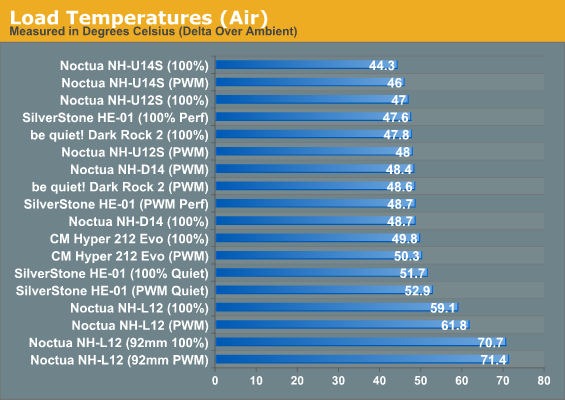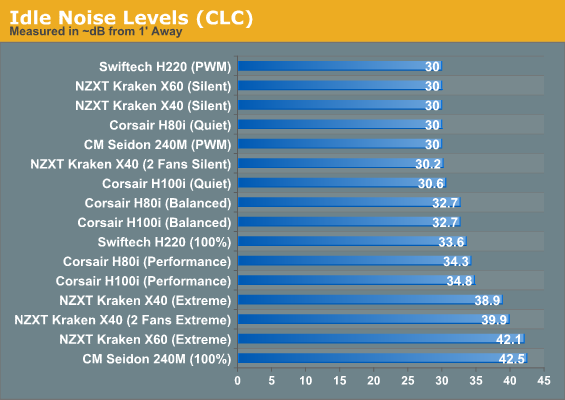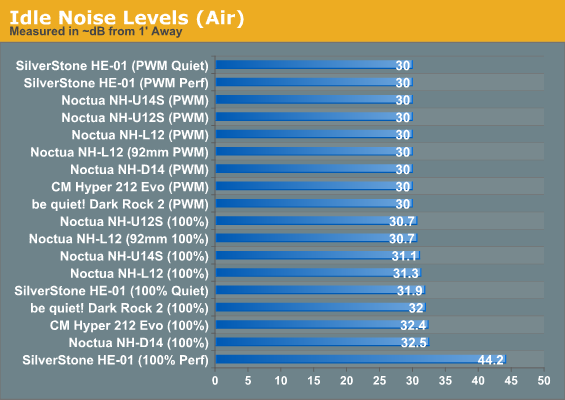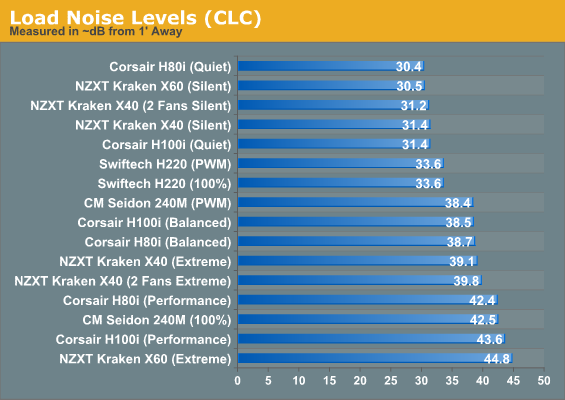Cooler Master Seidon 240M and 12 More Coolers: The Retest and Mega-Roundup
by Dustin Sklavos on April 26, 2013 6:01 AM ESTPrimary Test Results
Given that I tested thirteen coolers total, and all of them with at least two different data sets, there's a lot of ground to cover. I don't want to produce too many oversized tables, so I'll break down all of the test results into two categories: closed loop coolers, and air coolers. I'm also breaking down performance by load temperature, idle noise, and load noise.


There's a lot of data to digest here. First, it looks like the very best air cooling has to offer is only really hugging the bottom of what closed loop cooling can do, but that's a bit deceptive. The breaking point is actually when you go beyond a 120mm radiator, and even then it's not certain: Noctua's new NH-U14S, at its fastest, is a better performer than Corsair's H100i at its quietest setting.
What's missing from the above chart is the noise the closed loop coolers have to generate in order to beat the air coolers; the only exceptionally loud air cooler is the underperforming SilverStone HE-01, as you'll see below.


As you can see, the average idle noise on the air coolers is way, way lower than the closed loop units. That suggests that liquid cooling isn't in and of itself a plainly superior solution outside of Swiftech's H220 and the 280mm NZXT Kraken X60. It gets better, though.


Almost all of the air coolers are relatively silent under load, while the closed loop coolers produce a tremendous amount of racket if they're not configured for silent running.
If you're like our own Dr. Ian Cutress and interested only with getting as much cooling performance as you can out of your cooler, then the NZXT Kraken X60 continues to be the best option. However, note that the Swiftech H220 was able to produce thermals just one or two degrees warmer while running 10dB quieter. This is why some stores are having trouble keeping the H220 in stock: it's the best 240mm unit by a longshot, and it's even competitive with the beefier 280mm Kraken X60.
Also note that the two new Noctua coolers are meeting or beating their old standard, the NH-D14, and they're doing it while being quieter. The NH-D14 looks frankly overengineered compared to the NH-U12S.
Finally, Cooler Master's Hyper 212 Evo continues to be a tremendous value, offering reasonably competitive thermals and noise for an air cooler at a fraction of the cost.










62 Comments
View All Comments
spidey81 - Friday, April 26, 2013 - link
This article was to test the performance of the coolers at a certain clock speed. However, I think you would find that when pushing the overclock higher you would see some coolers wouldn't be able to keep the temps in check while others could. There's a difference between efficiently transferring the heat and the amount of heat capable of being transferred. That's why the D14 and TRUE are popular among overclockers who push higher than what we see in this test. To that end, the 240mm or 280mm closed loop coolers will also be able to handle higher overclocks.In this (http://www.overclock3d.net/reviews/cases_cooling/s... review of the H220, you can see that on the socket 2011 cpu the air coolers weren't able to maintain the extreme overclocks like the closed loop coolers could.
spidey81 - Friday, April 26, 2013 - link
sorry, link broke. http://tinyurl.com/cu24bwk That should work better :)epoon2 - Friday, April 26, 2013 - link
You meant that as the load/watt/heat produced by CPU increases, the order in this graph http://images.anandtech.com/graphs/graph6916/54390... changes?but in the above test, the fans are at constant, max speed already ... I know what you mean but I just can't figure out the science/reason behind why your scenario would happen.
BrightCandle - Friday, April 26, 2013 - link
Two key factors are at play:1) the amount of watts of heat the solution can dissipate at a given delta temperature to the air.
2) the thermal interface performance to the CPU itself and hence what temperature the CPU is running at.
Water is cooling the water block but then water itself is above ambient temperature. This often means the ambient temp CPU effectively sees is higher compared to what it was with air. But water warms and cools much faster than air by volume, and it can hold a lot more energy. Combining water with a substantially larger area to exchange its heat to air and you get a solution that cools better given a large number of watts of heat but does less well on low wattage where air cooling fits and is sufficient.
A 2600k pulls about 170W over clocked. A 3930k can be over 300W. 170W is about the point to consider water but you need an overspecced loop to show any advantage at all. Passed 200 watts however and water takes a clear lead and air stops being able to do the job.
epoon2 - Saturday, April 27, 2013 - link
Assuming the water pipes dissipates negligible heat, the role of the water system is equivalent to that of the thermal compounds: to transfer energy and heat to the sink and radiator.The difference in rate of heat exchange between the metal pieces and the external environment becomes the key.
In an open air test, the rankings should remain the same as amount of heat generated by the CPU increases. In the real world , the performance of air coolers depends on the effectiveness of the case's heat exchange system..
A5 - Friday, April 26, 2013 - link
For future reviews, I wouldn't mind seeing the Xigmatek SD1283 tested. A lot of people recommend it for people who want something better than the CM Evo but don't want to spend Noctua money. It typically runs ~$50 so it fits that niche price-wise as well.A5 - Friday, April 26, 2013 - link
I guess I meant the silly-named "Dark Knight 2" when I wrote this. Didn't know they had 2 different SD1283s. Guess I wouldn't mind seeing the cheaper, non-coated "Gaia" as well.Dr_b_ - Friday, April 26, 2013 - link
Does the U12 have socket 2011 mounting capability?epoon2 - Friday, April 26, 2013 - link
http://www.noctua.at/main.php?show=productview&...Dr_b_ - Friday, April 26, 2013 - link
thanks 4 link. NH-D14 is really too big, blocks a socket in my x79-UP4 gigabyte. U12 looks like it might work here.